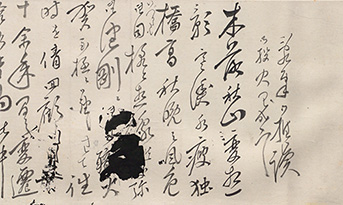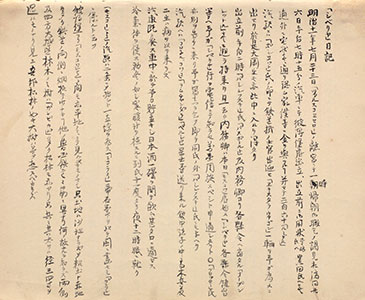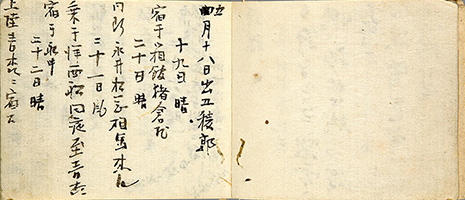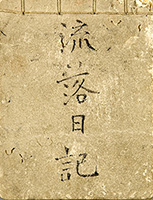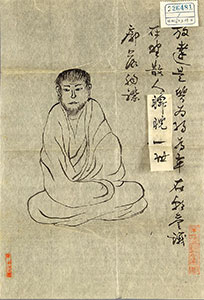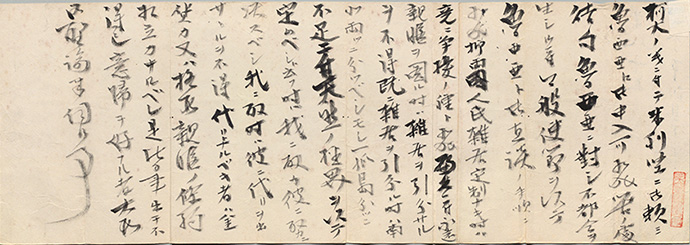- Top
- > Part 2: Modern era
- >Chapter 1: People at the end of the Edo period and the Meiji Restoration (2)
Chapter 1 People at the end of the Edo period and the Meiji Restoration (2)
SAIGO Takamori, 1827-1877
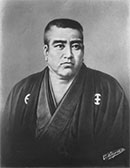 A politician at the end of the Edo period and in the Meiji era. He was a low-ranking feudal retainaer in the Satsuma Domain. He was picked by Shimazu Nariakira, the lord of the Domain, and actively engaged in movements such as supporting Hitotsubashi Yoshinobu as the successor to the Shogun. He concluded the Satsuma-Choshu Alliance through the intermediation of Sakamoto Ryoma. After the Second Choshu Expedition, he became a leader of the anti-Shogunate movement. He also realized the bloodless surrender of Edo Castle. He became sangi (councilor) in the new government but conflicted with Okubo Toshimichi and others over the Conquer Korea debate and resigned. After being defeated in the Satsuma Rebellion, he committed suicide by falling on his sword at Shiroyama. He was one of the “three great leaders of the Meiji Restoration”.
A politician at the end of the Edo period and in the Meiji era. He was a low-ranking feudal retainaer in the Satsuma Domain. He was picked by Shimazu Nariakira, the lord of the Domain, and actively engaged in movements such as supporting Hitotsubashi Yoshinobu as the successor to the Shogun. He concluded the Satsuma-Choshu Alliance through the intermediation of Sakamoto Ryoma. After the Second Choshu Expedition, he became a leader of the anti-Shogunate movement. He also realized the bloodless surrender of Edo Castle. He became sangi (councilor) in the new government but conflicted with Okubo Toshimichi and others over the Conquer Korea debate and resigned. After being defeated in the Satsuma Rebellion, he committed suicide by falling on his sword at Shiroyama. He was one of the “three great leaders of the Meiji Restoration”.
43 Saigo Takamori shokan, February 1, 1868[Makino Nobuaki Papers, Documents: C13]
This letter was written by Saigo to Okubo. In the letter, Saigo is encouraging Okubo to work for early resolution of the Kobe Incident (incident between feudal retainaers of the Okayama Domain and foreign soldiers near the foreign settlement in Kobe, and also cases of foreigners being murdered) that happened on January 11, 1868, when the battle of Toba-Fushimi was winding down. The letter shows that Saigo was concerned that the delay in resolution might cause the new government to be looked down on by other countries. Also, a postscript includes the name Earnest Satow, who was an interpreter of the British Minister (later British Minister), indicates that Saigo probably heard about the importance of the early resolution of the said incident from Satow.
OKUBO Toshimichi, 1830-1878
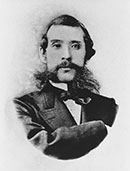 A politician at the end of the Edo period and in the Meiji era. He was from the Satsuma Domain. He promoted kobu gattai undo (the movement for union of the Imperial Court and the Shogunate) with Saigo Takamori and Iwakura Tomomi, but later he turned to be a leader of the anti-Shogunate movement. In the new government, he carried out hansekihokan (returning of land and people to the Emperor) and haihan-chiken (abolition of feudal domains and establishment of prefectures) and later he became okurakyo (Finance Minister) and also naimukyo (Home Minister). In 1878, he was assassinated by a discontented royalist. He was one of the “three great leaders of the Meiji Restoration” along with Saigo and Kido Takayoshi.
A politician at the end of the Edo period and in the Meiji era. He was from the Satsuma Domain. He promoted kobu gattai undo (the movement for union of the Imperial Court and the Shogunate) with Saigo Takamori and Iwakura Tomomi, but later he turned to be a leader of the anti-Shogunate movement. In the new government, he carried out hansekihokan (returning of land and people to the Emperor) and haihan-chiken (abolition of feudal domains and establishment of prefectures) and later he became okurakyo (Finance Minister) and also naimukyo (Home Minister). In 1878, he was assassinated by a discontented royalist. He was one of the “three great leaders of the Meiji Restoration” along with Saigo and Kido Takayoshi.
44 Okubo Toshimichi shokan, October 17, 1873[Sanjo Family Papers, Letters: 279-4]
A prospectus for resignation from sangi (councilor) Okubo submitted to Sanjo Sanetomi, dajo daijin (Grand Minister of State) saying, “The goal for staying in my position cannot be accomplished.” Okubo who became sangi according to the requests made by Sanjo, Iwakura Tomomi and others was against the Conquer Korea debate and opposed to sending Saigo Takamori to Yi Dynasty Korea as envoy. However, it was informally decided to send Saigo to Yi Dynasty Korea in the cabinet meeting on October 15, and Okubo submitted a letter of resignation on 17th along with this prospectus. This issue stayed unsolved until the Emperor Meiji accepted the opinion document from Iwakura on 24 and approved the indefinite postponement of sending Saigo. Saigo, losing in the Conquer Korea debate and resigned as sangi,returned to Kagoshima.
KIDO Takayoshi, 1833-1877
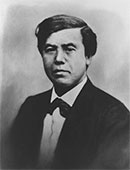 A politician at the end of the Edo period and in the Meiji era. His name was Katsura Kogoro but he changed his family name to Kido. He concluded the Satsuma-Choshu Alliance with Saigo Takamori and planned to overthrow the Shogunate. He participated in creating a draft Charter Oath of Five Articles and promoted hansekihokan (returning of land and people to the Emperor) and haihan-chiken (abolition of feudal domains and establishment of prefectures). He was against the Conquer Korea debate and the Conquer Taiwan debate and became out of the main stream for a while, but he was assigned as sangi (councilor) at the Osaka Conference. He was one of the “three great leaders of the Meiji Restoration”.
A politician at the end of the Edo period and in the Meiji era. His name was Katsura Kogoro but he changed his family name to Kido. He concluded the Satsuma-Choshu Alliance with Saigo Takamori and planned to overthrow the Shogunate. He participated in creating a draft Charter Oath of Five Articles and promoted hansekihokan (returning of land and people to the Emperor) and haihan-chiken (abolition of feudal domains and establishment of prefectures). He was against the Conquer Korea debate and the Conquer Taiwan debate and became out of the main stream for a while, but he was assigned as sangi (councilor) at the Osaka Conference. He was one of the “three great leaders of the Meiji Restoration”.
45 Kido Takayoshi shokan, September 14, 1872[Inoue Kaoru Papers: 357]
This letter was written by Kido, who was visiting Europe and the Americas as a deputy ambassador of the Iwakura Mission, to Inoue Kaoru in Japan. The approximately 7.5-meter-long letter starts with a memoir of hardships and sacrifices during the Meiji Restoration which was followed by criticism of Japan’s hasty modernization with no inner policy. He mentions 26-year-old Mori Arinori, who was working in Washington, and says “It is only appearance, with no inner policy”. Knowing the hardships during the Meiji Restoration and doing his utmost for establishing a new government, it can be seen that it was hard to tolerate for Kido to accept Mori’s behavior, who could easily become critical of the Japanese Government towards a foreign country.
ENOMOTO Takeaki, 1836-1908
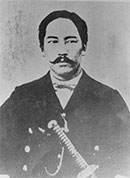 A soldier at the end of the Edo Period and in the Meiji era, and also a politician. After he studied seamanship and navigation under Katsu Kaishu at the Navy Officer Training School in Nagasaki, he went to the Netherlands to study natural science and law. He returned to Japan in the completed Kaiyo Maru, and became Vice President of the naval force of the Shogunate. In the Boshin War, he barricaded himself in Goryokaku of Hakodate City and fought with the New Government army but surrendered. He was granted a special pardon and held various positions of minister in the new government. He also played an active role when designated as the Japanese minister in Russia and concluded the Treaty of Saint Petersburg (Sakhalin-Chishima Exchange Treaty).
A soldier at the end of the Edo Period and in the Meiji era, and also a politician. After he studied seamanship and navigation under Katsu Kaishu at the Navy Officer Training School in Nagasaki, he went to the Netherlands to study natural science and law. He returned to Japan in the completed Kaiyo Maru, and became Vice President of the naval force of the Shogunate. In the Boshin War, he barricaded himself in Goryokaku of Hakodate City and fought with the New Government army but surrendered. He was granted a special pardon and held various positions of minister in the new government. He also played an active role when designated as the Japanese minister in Russia and concluded the Treaty of Saint Petersburg (Sakhalin-Chishima Exchange Treaty).
46 Shiberiya nikki ko, 1878[Enomoto Takeaki Papers: 8]
Diary written by Enomoto while he was crossing Siberia. He was dispatched to Russia to solve the Northern territories problem as envoy extraordinary, and concluded the Treaty of Saint Petersburg (Sakhalin-Chishima Exchange Treaty) in May 1875. He stayed in Russia and became the first Japanese minister in Russia. In 1878, he crossed Siberia using trains and carriages and returned to Japan. This diary is a record of 66 days of his trip. He wrote about various subjects including geography, climate, plants, politics and economy. On July 26, the day of his departure, he described how the ticket was handed to him and that he opened the bottle of Japanese sake he reserved in the train but did not like the taste.
OTORI Keisuke, 1833-1911
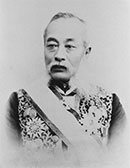 A soldier at the end of the Edo period and in the Meiji era. A diplomat. He learned Dutch studies and Western military science and became an executive of the Shogunate army. In the Boshin War, he went to Hokkaido with Enomoto Takeaki, but surrendered in the Battle of Goryokaku. Later he was picked by the Meiji government and held positions such as the head of Kobu Daigakko (the Engineering Grand School) and the Japanese Minister in Qing.
A soldier at the end of the Edo period and in the Meiji era. A diplomat. He learned Dutch studies and Western military science and became an executive of the Shogunate army. In the Boshin War, he went to Hokkaido with Enomoto Takeaki, but surrendered in the Battle of Goryokaku. Later he was picked by the Meiji government and held positions such as the head of Kobu Daigakko (the Engineering Grand School) and the Japanese Minister in Qing.
47 Ryuraku nikki, May 18-June 30, 1869[Otori Keisuke Papers: 1]
In 1869, seven people including Enomoto Takeaki and Otori Keisuke who surrendered in the Battle of Goryokaku were sent to Tokyo and imprisoned. This is a diary written by Otori during his transfer starting from Goryokaku on May 18 to Senju on June 29. It is a simple diary basically with dates, weather and places they stayed. Some days have places they ate lunch and the distance they moved. It also includes how their stopping places were affected by the Boshin War, showing his military sense.
An early example of a portable writing kit
Looking at Materials 48 Otori Keisuke, you might wonder how this travel diary was written during an age when writing instruments were actually quite cumbersome. In fact, ancient travelers had used portable writing kits, called yatate, since the 13th century in Japan. Yatate were a kind of portable case that held a small writing brush and an inkpot, in which a little cotton was often used to hold the ink. During the Edo period, as commercial activities grew, a yatate was an essential item for travelling merchants, and their use remained widespread until the modern era.
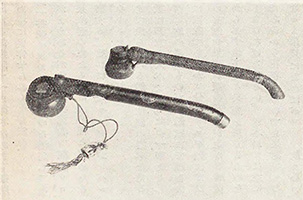
Natural science and museums, 4(9)(45), Kokuritsu Kagaku Hakubutsukan, September, 1933[Z14-213]
KATSU Kaishu, 1823-1899
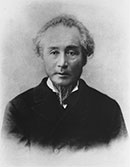 A vassal of the Shogun at the end of the Edo period and a politician in the Meiji era. He changed his name to Yasuyoshi after the Meiji Restoration. He studied seamanship and navigation at Kaigun Denshu-jo (Japanese Naval School in Nagasaki), sailed across the Pacific Ocean as the captain of the Kanrin Maru, and went to the United States. When he returned to Japan, he devoted himself to developing the Shogunate navy. In the Boshin War, he met with Saigo Takamori as the representative of the Shogunate and realized the bloodless surrender of Edo Castle. After the Meiji Restoration, he assumed the post of kaigunkyo (Minister of the Navy), a member of the Chamber of Elders and a privy councilor.
A vassal of the Shogun at the end of the Edo period and a politician in the Meiji era. He changed his name to Yasuyoshi after the Meiji Restoration. He studied seamanship and navigation at Kaigun Denshu-jo (Japanese Naval School in Nagasaki), sailed across the Pacific Ocean as the captain of the Kanrin Maru, and went to the United States. When he returned to Japan, he devoted himself to developing the Shogunate navy. In the Boshin War, he met with Saigo Takamori as the representative of the Shogunate and realized the bloodless surrender of Edo Castle. After the Meiji Restoration, he assumed the post of kaigunkyo (Minister of the Navy), a member of the Chamber of Elders and a privy councilor.
48 Katsu Kaishu jigazo[Katsu Kaishu Papers: 43]
Katsu’s self-portrait with his own san (poem or sentences added to the work). His san says, “I do not care about small things. I can be a general, and I can be a common soldier. I will be sangi (councilor) at the Imperial Court, and I will be an ordinary person when out of power. Whichever situation I am in, I will take it as it is and see the situation”. It seems to be written when he was out of power but it is not clear when it was written.
FUKUZAWA Yukichi, 1834-1901
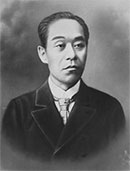 An enlightenment thinker and an educator in the Meiji era. He learned Dutch studies from Ogata Koan in Osaka and established a Dutch studies school (later Keiogijuku). He studied English by himself and went to Europe and the Americas three times including the time he accompanied the Shogunate’s delegates in the Kanrin Maru. After the Meiji Restoration, he was engaged in the education and enlightenment campaign. He published Jiji shimpo and wrote Seiyo jijo (lit. Conditions in the West), Gakumon no susume (An encouragement of learning), Fuku-o jiden (The autobiography of Fukuzawa Yukichi) and others.
An enlightenment thinker and an educator in the Meiji era. He learned Dutch studies from Ogata Koan in Osaka and established a Dutch studies school (later Keiogijuku). He studied English by himself and went to Europe and the Americas three times including the time he accompanied the Shogunate’s delegates in the Kanrin Maru. After the Meiji Restoration, he was engaged in the education and enlightenment campaign. He published Jiji shimpo and wrote Seiyo jijo (lit. Conditions in the West), Gakumon no susume (An encouragement of learning), Fuku-o jiden (The autobiography of Fukuzawa Yukichi) and others.
49 Fukuzawa Yukichi shokan, February 5, 1892[Enomoto Takeaki Papers: 25]
This letter was written by Fukuzawa to Enomoto Takeaki. In the letter, Fukuzawa was asking Enomoto to check if the contents of the draft for Yasegaman no setsu (refer to the column) sent on 27 of the previous month is true because he is planning to publish it at the right time. Enomoto, who was a Minister of Foreign Affairs at that time, wrote back and only said “I am busy now so I will give you my opinion some time”. Katsu Kaishu was asked the same question and he wrote back and said, “My course of action is my business and no one else’s. Others may take it as they like. It does not matter to me and I do not care”.
 “Yasegaman no setsu” by FUKUZAWA Yukichi
“Yasegaman no setsu” by FUKUZAWA Yukichi
“Yasegaman no setsu” was written by Fukuzawa Yukichi around the winter of 1891. In this column, he was criticizing Katsu Kaishu and Enomoto Takeaki who used to be vassals of the Shogun but served the new government and were promoted to high positions. Fukuzawa sent this draft to Katsu and Enomoto in January 1892 and asking for their response (Materials 49 is a request for Enomoto to respond). In the letter, Fukuzawa commented on Katsu who realized the bloodless surrender of Edo Castle without fighting with government army (later Meiji government) and said “You have depreciated the importance of yase-gaman (fake stoicism) which is unique to the Japanese people and led to lowering of the morale that is indispensable for our country to keep on going. It cannot be overlooked”. He criticized Katsu for having a position with honor and profit provided by the Meiji government after the Restoration as if he deserved it.
Also about Enomoto, he evaluated highly his raising an army against the government army in Hakodate and his spirit of samurai, which is yasegaman, but he said he cannot agree with the fact he assumed an important position in the Meiji government after he was released.
About ten years later, during the New Year of 1901, “Yasegaman no setsu” was published in Jiji shimpo. In May of the same year, it was combined with “Teichu koron” into one book and was published by Jiji Shimposha (Meiji 10nen Teichu koron Yasegaman no setsu[304-H826m]).
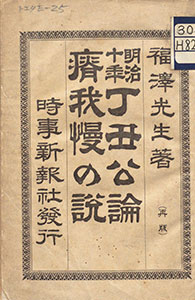
SOEJIMA Taneomi, 1828-1905
 A politician at the end of the Edo period and in the Meiji era. He was from the Saga Domain. He joined sonno-joi undo (lit. movement to revere the Emperor and expel the barbarians) and became a consultant of the new government. He devoted himself to making a draft of Seitai-sho (Constitution of 1868 or the June Constitution). He served as gaimukyo (Foreign Minister) and held negotiations with Russia over the Karafuto boundary issue, but he was against the Conquer Korea debate and resigned with Itagaki Taisuke, Eto Shimpei and others. Later he served as Privy Councillor and Home Minister of the first Matsukata Cabinet. He is also known as noshoka (master of calligraphy).
A politician at the end of the Edo period and in the Meiji era. He was from the Saga Domain. He joined sonno-joi undo (lit. movement to revere the Emperor and expel the barbarians) and became a consultant of the new government. He devoted himself to making a draft of Seitai-sho (Constitution of 1868 or the June Constitution). He served as gaimukyo (Foreign Minister) and held negotiations with Russia over the Karafuto boundary issue, but he was against the Conquer Korea debate and resigned with Itagaki Taisuke, Eto Shimpei and others. Later he served as Privy Councillor and Home Minister of the first Matsukata Cabinet. He is also known as noshoka (master of calligraphy).
50 Soejima Taneomi ikensho, ca. 1871[Sanjo Family Papers, Documents: 47-6]
A statement written by Soejima concerning a solution for the Karafuto boundary issue between Russia and Japan. It seems to have been submitted to Sanjo Saneomi, daijo daijin (Grand Minister of State). From the end of the Edo period to the early Meiji era, Karafuto was considered to belong to both Japan and Russia, and people from both countries lived there. However, Russia which wanted to possess the islands by itself sent militaries and exiles, increasing anti-Japanese movement. Soejima was engaged in the Karafuto issue as sangi (councilor) from around 1870 and later as gaimukyo (Foreign Minister). After he resigned due to the Conquer Korea debate, this issue was left unsolved until the Treaty of Saint Petersburg was signed in 1875.
51 Soejima Taneomi shokan, November 20, 1895 [Ito Hirobumi Papers (No.1), Letters: 294-1]
This letter was written by Soejima who was a president of the Toho Kyokai (a study group for studies on foreign countries in the east) to Ito Hirobumi who was Prime Minister. In the letter, Soejima said the proposal made by Toho Kyokai concerning Japan’s policy and measures towards the East and the world after the Sino-Japanese War would be submitted. Toho Kyokai was a group formed in 1891 with Soejima, Konoe Atsumaro and others as the center to investigate geography, trade, history, etc., concerning Eastern countries and South Sea Islands. As written in the letter, the proposal appeared on No.16 of Toho kyokai kaiho.





